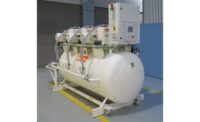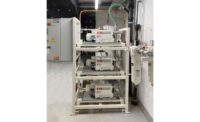Busch vacuum pumps operating at hospital in Wuhan, China

The Huoshenshan Hospital attracted worldwide attention at the beginning of the month. It was built in just a few days in the Chinese city of Wuhan to accommodate patients infected with the coronavirus. The hospital has been officially in operation since February 3, 2020. Busch Vacuum Solutions supplied twelve vacuum pumps for the central vacuum supply of the entire hospital, and they were installed within two days.
In response to the coronavirus epidemic in Wuhan, the authorities quarantined the entire city on January 23. The construction of Huoshenshan Hospital started on the same day. A total of 4,000 workers were deployed during the construction phase, working around the clock in three-shift operation. Busch delivered the vacuum pumps on February 1. They were assembled on site to form a central vacuum system. Via a pipeline network, this system supplies the entire hospital with vacuum for the extraction of body secretions and virus-infected breathing air.
The hospital officially opened on February 3. Since Monday the hospital has been fully occupied with 1,000 patients. A total of up to 1,400 medical professionals are expected to work in this hospital. Some of them will have been recruited from the army. However, many volunteers from all over the country have also signed up to work in the hospital. The construction of a second hospital in Wuhan was started at the same time, but has not yet been completed.
The Chinese employees who installed the vacuum pumps have either returned home after their assignment or are still staying in hotels. In both cases they are under quarantine and may only leave their accommodation with official permission. However, there have not been any cases so far of Chinese Busch employees being infected with the coronavirus. The vacuum pumps have been running day and night since February 3. The engine room in which they are housed may only be entered by authorized personnel of a state company under considerable safety precautions.
Busch has been supplying hospitals in China with vacuum pumps for a long time. Only last November, a Chinese delegation of state hospital operators and manufacturers of medical vacuum supply systems visited Busch in Maulburg to find out about the latest vacuum technology. Many Chinese hospitals are equipped with outdated vacuum pumps made in China that use water as an operating fluid. This carries the risk that viruses or bacteria can accumulate in the water circuit and escape from the pumps under unfortunate circumstances, such as leaks, or during maintenance work. Busch, on the other hand, supplies vacuum pumps that manage completely without operating fluids and are run at high temperatures that kill viruses or bacteria. But the major significance of this technical distinction was not yet apparent when the Chinese delegation visited Maulburg at that time. A vacuum specialist from Maulburg has since traveled to China to advise hospital operators there and support local Busch employees.
Looking for a reprint of this article?
From high-res PDFs to custom plaques, order your copy today!






